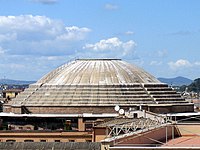
Photo from wikipedia
Abstract Nowadays, steam curing has become an effective way to produce high early strength concrete prefabricated elements. However, this curing regime has been proved to lead to the heat damage… Click to show full abstract
Abstract Nowadays, steam curing has become an effective way to produce high early strength concrete prefabricated elements. However, this curing regime has been proved to lead to the heat damage on the microstructures and properties of concrete. Therefore, how to characterize the heat damage, and the impact of heat damage on the durability of concrete is a key issue. In this study, three treatment temperatures were employed to study the heat damage of steam-cured concrete. In addition, the surface gas permeability (SGP), water intentional spraying tests (WIS), pore structure, TG-DSC and SEM were measured to analyze the effects of curing regimes on performance of steam-cured concrete. The results indicate that there are differences in the surface and interior of steam-cured concrete, and surface permeability (SGP and WIS) can characterize these differences. Meanwhile, high temperature steam curing is detrimental to the long-term impermeability of concrete, and surface treatment can improve this phenomenon. The surface covered by geotextile has the lowest permeability and relatively dense microstructures.
Journal Title: Journal of building engineering
Year Published: 2020
Link to full text (if available)
Share on Social Media: Sign Up to like & get
recommendations!